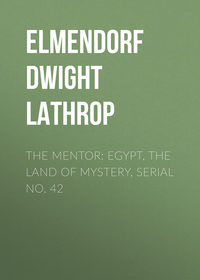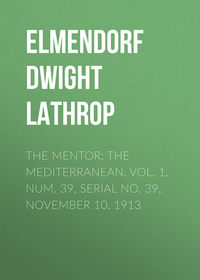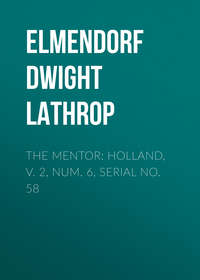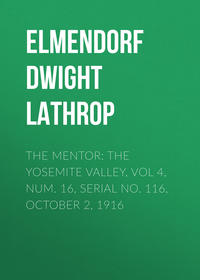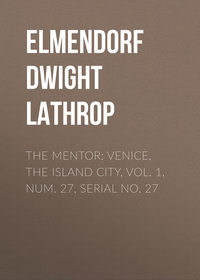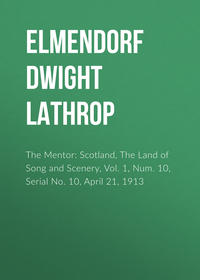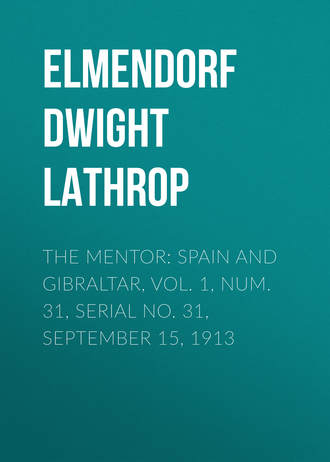
The Mentor: Spain and Gibraltar, Vol. 1, Num. 31, Serial No. 31, September 15, 1913
After Castile had thrown off Moorish rule Seville was made the capital of Spain. For several centuries Christian kings lived in the Alcázar, adding somewhat to the original structure as the Moors had left it. The name of Pedro is more closely connected than any other Spanish ruler with the history and fiction of the building. He was called Pedro the Cruel. A grim sense of humor and a habit of going through the streets of Seville in disguise have made him the subject of many odd tales and rumors. Some of these stories are merely whimsical. He is said to have met four candidates for a judge’s position beside a pool in the gardens where they had gone to find him. Pedro, turning to the first, asked him what was floating in the pool.
“An orange,” replied the candidate without hesitation.
The second and third gave him the same answer.
The fourth fished out the piece of fruit with his staff, examined it, and replied more accurately, “Half an orange.”
Pedro immediately gave him the appointment.
SPAIN AND GIBRALTAR
Cathedral of Seville
FOURThere is a Spanish proverb that says, “Whom God favors he gives a house in Seville.” The privilege of living in that bright, gay city is considered by a Spaniard to be the height of happiness. Other cities are larger, wealthier, or more important politically than Seville; but none holds a higher place in the hearts of the Spanish people. When in the beginning of the fifteenth century the old cathedral was damaged by an earthquake, a meeting was held to discuss what should be done to restore it. Then one proposed that, instead of repairing the old church, they should build a new edifice, larger and more magnificent than had ever been imagined. They planned a cathedral that should make all who saw it wonder at the daring of those who began it. What the public funds would not supply they agreed to furnish out of their own purses.
Only 117 years were consumed in the erection of this wondrous structure, which is a short time as old cathedrals go. After St. Peter’s at Rome and the Mezquita at Cordova, it is the largest church in the world. It is 414 feet long, 271 feet wide, and 100 feet high to the top of the nave. The immense pillars, as you look down the church between them, seem to diminish in the distance to the thickness of reeds. Many another cathedral could stand inside the nave of this one.
There are numerous churches in the city; most of the older ones are built on the foundations of mosques. The church of La Caridad has a strange legend connected with it. Don Miguel de Manara, the founder, had been a profligate in his youth, a sort of Don Juan, and was known far and wide for his excesses. One night when he was returning home alone he lost his way, and wandered about in a daze, unable to find his home. In imagination he met a funeral procession, and stopping one of the bearers inquired who it was that they were taking to eternal rest at such an hour.
“Don Miguel de Manara,” he replied.
Greatly surprised at hearing his own name, Don Miguel uncovered the face and saw there his own features. The procession immediately vanished; but left him so deeply impressed that he was converted and built a church and a hospital.
SPAIN AND GIBRALTAR
Siege of Granada
FIVEThe city of Granada was the last Moorish stronghold in Spain. The usurpers had been driven from province after province, while the power of Castile increased in all the country round. Only the province of Granada held firm. Even there, losses in war had so weakened the Moors that their kings paid tribute to the Christian rulers, down to the time of Muley Hassan. He was a proud and cruel monarch, so fond of the dignity his fathers had held that he not only withheld the tribute, but even made inroads into Spanish territory.
A ten years’ war followed. Spain determined to drive her enemy out of Europe once and for all. In battle after battle the Christians narrowed Hassan’s kingdom, till the people of Granada rose in revolt against the ruler whose bad luck and tyranny made him so unpopular. He was dethroned, and the kingdom given to Boabdil, his son. Boabdil was if anything more unfortunate than his father; for Ferdinand and Isabella pushed their conquest little by little up to the very walls of Granada.
A long siege followed. The Moors, as they lost the power they had held so long over the rich and delightful lands of Spain, tried every trick of warfare without effect. Ferdinand had given orders not to attack the city. He intended to win by starving his enemies rather than by fighting, while the Moors did all they could to provoke a battle. One daring knight named Yarfe rode out of the gates; unexpectedly he made his way to the Christian camp, and threw a spear into the ground close by the royal pavilion as an insult to Queen Isabella. In return Hernando del Pulgar, disregarding the order of Ferdinand, broke through the gates of Granada with a few followers and pinned a tablet on the door of a mosque with his dagger. Upon the tablet were the words, “Ave Maria.” Thus the knights of both sides showed their recklessness under the long siege.
The Spanish army lay so long encamped on the vega (plain) within view of the city walls and the magnificent buildings of the Alhambra that at last, after the tents had been accidentally burned, Ferdinand ordered a city to be built for the soldiers. Each of the towns of Spain sent its share of materials and in a remarkably short time Santa Fé, as it was called, stood side by side with Granada.
When all the vega was laid waste, when the Moors were starving and discontented, and a hostile walled city frowned in sight of the Alhambra, Boabdil at length made terms of peace. He said farewell to the palace of Moorish kings and all the luxuries he had enjoyed as its ruler, surrendered the keys of the city to Ferdinand, and went away greatly humbled. Never afterward did the Moors hold power in Spain.
SPAIN AND GIBRALTAR
Rock of Gibraltar
SIXOne night over two centuries ago a band of Spaniards, led by a goatherd, crept up the rock of Gibraltar to St. Michael’s cave, where dawn overtook them, and where they remained all through the next day. As soon as darkness had fallen again they scaled the wall, surrounded the signal house, and in a few moments overpowered the guard. The British in the fortress never dreamed of danger so close at hand. Ropes and ladders were lowered stealthily over the precipice, and the Spaniards, feeling sure of victory, brought up several hundred men for the attack. If all had gone well, Gibraltar might have been in the hands of Spain again before sunrise; but some part of the work was clumsily done, for British sentries caught the alarm, and a body of grenadiers, hastily called together, rushed out upon their midnight assailants. Gibraltar was saved for the British. Some of the Spaniards they hurled over the cliff; the rest surrendered and were taken prisoners.
The history of Gibraltar was for many centuries one of sieges and captures. The rock was first known to the Greeks and Romans as one of the pillars of Hercules; the other, Mt. Abyla, stands on the African shore. But at that period, when ships rarely sailed out of the Mediterranean, the “pillar” was unimportant to any great nation in war. It fell into the hands of Phoenicians, Romans, Carthaginians and Visigoths at different periods in history. Tarik, landing there when he crossed from Africa into Spain, built a castle on the rock, which was therefore called Gebel-al-Tarik (Hill of Tarik), the original form of the name Gibraltar. It fell into the hands of England after the Spaniards and Moors had fought over it for centuries.
Once again, in the great siege that began in 1779 and lasted more than three years, England came dangerously near losing the fortress. Spain and France took advantage of British losses in America to open fire on the Mediterranean stronghold. After the garrison of over 5,000 men had been reduced to starvation, and only the bravery of General Eliott could keep them together, Gibraltar was bombarded from the mainland. Just when his command seemed lost under the strain of attack and of hardships endured so long, the Scotsman led his troops to the attack, and, taking the much larger Spanish army by surprise, drove them back and burned their fortifications. Again Spain and France attacked from the sea; but Eliott burned their ships with redhot cannonballs. The struggle was renewed from time to time all during the siege, until at last peace was proclaimed. General Eliott, returning home, was received with the highest military honors for his courage.
England has been offered all of Spain’s possessions in Africa in exchange for the one great sterile rock; yet nothing will induce her to give up that hold on the gate of the Mediterranean.


